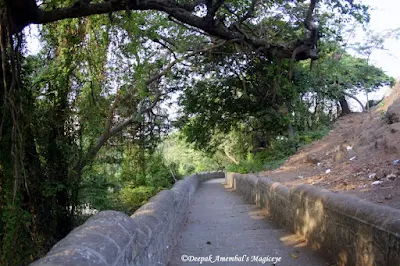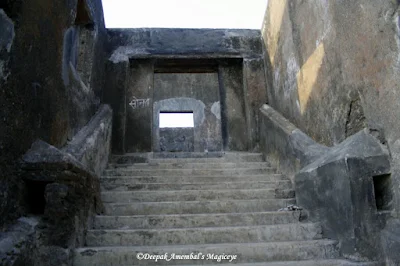WALES, JAMES (1747-1795)
VIEW FROM SION FORT
Used with permission from the Peter Anker Collection held in the Kulturhistorisk Museum at the University of Oslo, Norway.
PLATE 11: VIEW FROM SION FORT, 1791-1792.
In this second Plate [No. 11] James Wales provides an alternative panoramic view from the Sion Fort. From the vantage of Sion Fort, the view opens out to the island of Mahim. In this scene the walls of the fort dominate the foreground, with the curving line of the ramparts and an imposing cannon mounted in the battlement wall. The rising staircase and buildings behind the gun carriage are surmounted by a flagstaff asserting British sovereignty over the island. In other versions of this Plate there is no flag suspended on the flagstaff, so its inclusion here is an intriguing anomaly [cf: coloured etching held by Yale Center for British Art, listed as Plate 11, dated 1800, London].
The figures descending the stairs provide an ironic yet humorous counterpoint to the scene. There is the stout portly figure of an English military official whose waist is bursting from his red uniform, clearly the figure of a buffoon. He is accompanied by a European woman whose hand he holds; behind them follow two figures, one of whom is a woman carrying a small child. The status of these other women is unclear. The companion is clearly a figure of affection, while the woman in blue is presumably a nanny or wetnurse to the child. A one-legged, one-armed sepoy veteran stands waiting to greet the group, thereby highlighting the additional use of the fort as a sepoy hospital or hospice for military veterans. Once again the flat lands below the fort stretch into the indeterminate distance under a wide dominating sky. There are buildings and plantation areas with associated coconut palms in the middle distance, as well as thick clusters of native trees. On the far right of the picture, though significantly trimmed in this versio, is a pagoda, tomb or sati pavilion.
View from Sion fort towards east in Bombay in 1815
The view looks down from the Sion Fort gate to Bombay and the Neat's Tongue, bounded by the Mahratta Mountains. The Sion Fort was constructed in 1669/77 by the Governor of Bombay, General Gerald Aungier and it commanded the passage from Bombay to the neighbouring island of Salsette. The fort was of great importance to the British because Salsette was under the control of the Marathas.
Courtesy British library
This is plate 10 from James Wales' 'Bombay Views'. The series was painted for Sir Charles Malet (1752-1815), the British Resident of Poona, who Wales met in Bombay in 1791
This is plate 10 from James Wales' 'Bombay Views'. The series was painted for Sir Charles Malet (1752-1815), the British Resident of Poona, who Wales met in Bombay in 1791
a two wheeled bullock cart can be seen


his hillock is situated a few metres east of the Sion railway station.
Sion was the boundary between British-held Parel island and Portuguese held Salsette Island and the fort marked the northeast boundary of their possession.


1526 -Bombay--naval fight between Gujerat sultan's fleet and Portuguese navy from Colaba via Sion to Bandra
Goa, Direita Street:

On leaving Chaul for Diu, 'on the day after Shrove Tuesday,' Sampayo came unexpectedly on the Cambay fleet in Bombay harbour. After a furious cannonade the Portuguese boarded the enemy and Alishah fled hoping to escape by the Mahim creek.But the Portuguese had stationed boats at Bandra, and all Alishah's vessels but seven were taken. Of the seventy-three prizes thirty-three were fit for work and were kept; the rest were burned. Besides the vessels many prisoners were made, and much artillery and abundance of ammunition were taken. [Feria in Kerr's Voyages, VI. 209, 210. This summary of Faria's account of the battle of Bombay seems to differ in some particulars from the account in De Barros.' Asia (Decada, IV. Part I. 208-210,Lisbon Ed. of 1777). According to De Barros the Portuguese caught sight of the Gujarat fleet off a promontory. As Sylyeira drew near, the Gujrat fleet retired behind the promontory, and he sent some ships to guard the mouth of the river.
Xarafo or money changer of Kingdom of Cambay. Clients include three Portuguese
When Sylveira drew near, the Gujarat ships set sail and ran into the river, and when they found that the mouth of the river was occupied, they tried to reach Mahim fort, but, before they reached Mahim, they were surrounded and captured by the Portuguese boats which had been sent to, guard the mouth of the creek. This account is not altogether clear. Apparently what happened was that when the Gujrat boats saw the Portuguese, they drew back from the Prongs Point into the Bombay harbour, and when the Portuguese fleet attacked them, they fled up the harbour to the mouth of the river (that is the Bombay harbour or east mouth of the Mahim creek) not daring to try their fortune is the open sea.'
Portuguese ships, 16th century
The Portuguese captain learned from his local pilots that the Gujarat fleet probably meant to retreat through the Bandra creek, and accordingly sent boats to guard its mouth. The Gujarat fleet entered the creek by Sion, and, on nearing Mahim, saw the Portuguese boats blocking the entrance of the creek.
To avoid them they made for the Musalman fort of Mahim, at the south end of the present Bandra causeway, but the Portuguese saw their object and coming up the creek cut them off,
Portuguese ship
De Barros' account has been supposed ('Lateen' in Times of India, 21st April 1882) to favour the view that the fight was not in the harbour, but in the open sea off Malabar point. To this view the objection are, that when the Gujarat fleet retired behind Colaba point on catching sight of the Portuguese, they must have gone into Back Bay a dangerous and unlikely movement. That if they came out again to fight, they must have seen the Portuguese boats being sent on to Bandra, and that when, in their flight, the Gujarat fleet found the mouth of the Bandra creek blocked, they could not have attempted to take shelter in Mahim.
| The city of Cambay was an important Indian manufacturing and trading center noted by Marco Polo and illustrated here in the 15th century. BIBLIOTHEQUE NATIONALE / ARCHIVES CHARMET / BRIDGEMAN ART LIBRARY (BOUCICAUT MASTER) |
the attempt to take shelter in Mahim, when the mouth of the creek was found to be blocked, shows that the Gujarat fleet was leaving not entering the Bandra or Mahim river.]
| Mahim Fort |
Portuguese battles in the Indian Ocean | |
|---|---|
Cannanore (1501) –Calicut (1502) – Cochin (1504) –Cannanore (1506) – Anjadiva (1506) – Ormuz (1507) –Cannanore (1507) – Chaul (1508) – Dabul (1508) –Diu (1509) – Goa (1510) – Malacca (1511) – Calicut (1526) –Chalium (1531) – Diu (1538) –Diu (1546) – Aden (1548) –Hormuz campaign – (Muscat – Gulf of Oman) –Malacca (1568) –Malacca (1606) –Battle of Cape Rachado (1606) –Swally (1612) – Ormuz (1622) –Action of one February (1625) – River Duyon (1629) –Goa (1638) – Calicut (1752) | |
1538 Siege of Diu , india
The Portuguese fortress of Diu had a garrison of 600 Portuguese commanded by D. António da Silveira.
The Turk Suleiman Pasha and the Sultan of Cambay united their armies, and arrived at Diu with 70 Turkish galleys and a land army of 23.000 men.
Having taken some Portuguese as prisoners, Suleiman Pasha sent a letter by one of the prisoners to be delivered to D. António da Silveira.
When António da Silveira received the letter from the Turk, he turned to his companions saying: Let us see what does the dog has to say, and read the letter in public.
Suleiman Pasha promised the Portuguese free leave of people
and goods
as long as they returned to the Coast of Malabar and handed over the fortress and their weapons.
Suleiman promised to skin alive all of the Portuguese if they did not obey his conditions
referring that he had the largest army in Cambay
among which were many who participate in the taking of Belgrade, Hungary and the Island of Rhodes.
Finally he asked António da Silveira how would he defend the pig-sty with so few pigs!
D. António da Silveira ordered paper and ink to be brought forward, and in the presence of all, dictated the reply to the Pasha :
Most honored captain Pasha, I have carefully read your letter.
If in the Island of Rhodes were the knights that are in this pig-sty you could be assured that you would have not conquered it .
You have to learn that here are Portuguese
used to killing many Moors
and are commanded by António da Silveira that has a pair of balls stronger than the balls of your canons
and that all the Portuguese here have balls and do not fear those who don’t have them .
A bigger insult could not be imagined.
The Pasha was furious and ordered that the remaining prisoners were killed, and a fight of giants begun.
During more then a month António da Silveira fought bravely, remaining only less than 40 Portugueses capable of fighting, but causing so many casualties to the Turks that these gave up the siege and
retired from Diu